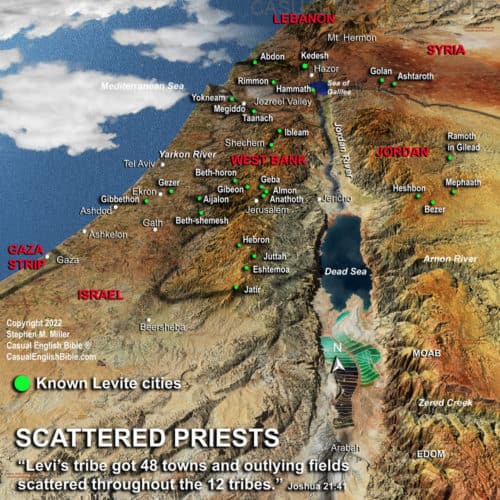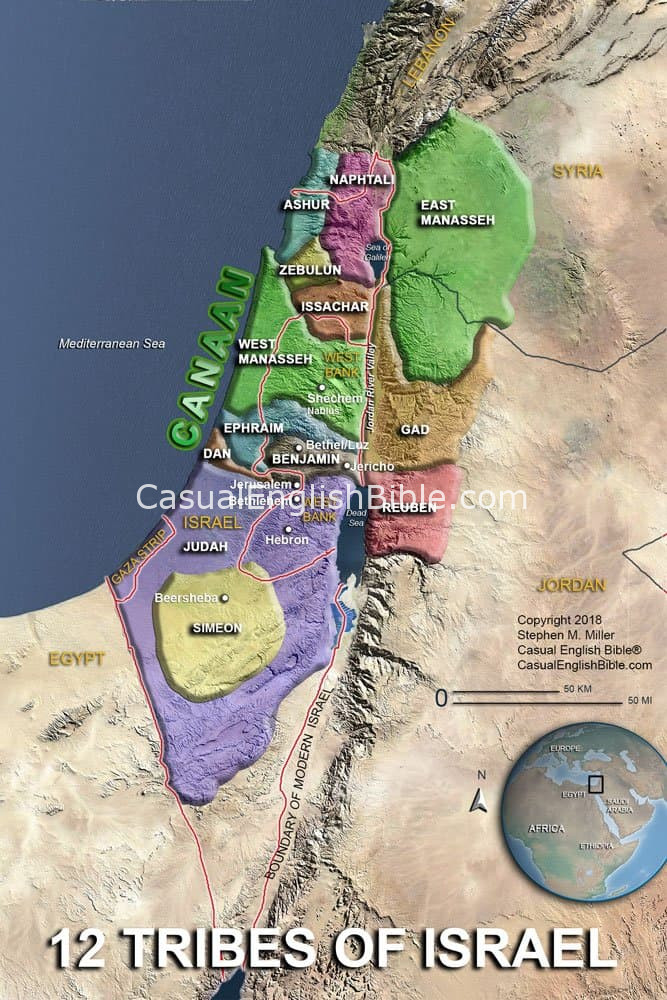1 Chronicles 6
Scattered towns for Levi’s family
Family tree of Levi
1Levi had three sons: Gershon, Kohath, and Merari.2Kohath had four sons: Amram, Izhar, Hebron, and Uzziel. 3Amram had three children: Aaron, Moses, and Miriam. Aaron had four sons: Nadab, Abihu, Eleazar, and Ithamar.
4Eleazar had one son: Phinehas. Phinehas’s descendants continued one generation after another, father then son: Abishua, 5Bukki, Uzzi, 6Zerahiah, Meraioth, 7Amariah, Ahitub, 8Zadok, Ahimaaz, 9Azariah, Johanan, 10Azariah (Israel’s high priest when King Solomon built the first Israelite Temple in Jerusalem), 11Amariah, Ahitub, 12Zadok, Shallum, 13Hilkiah, Azariah, 14Seraiah, and Jehozadak.
15Babylonian invaders led by their King Nebuchadnezzar deported Jehozadak into exile with many others from Jerusalem and Judah. But it was really God who exiled them. [1]
Levi’s clans
16Levi had three sons: Gershom, Kohath, and Merari. 17Gershom had two sons: Libni and Shimei. 18Kohath had four sons: Amram, Izhar, Hebron, and Uzziel. 19Merari had two sons: Mahli and Mushi. These were leaders of clans in Levi’s tribe, according to their genealogy.20Gershom had one son: Libni. Family generations continued from father to son, beginning with Libni’s son Jahath and then: Zimmah, 21Joah, Iddo, Zerah, and Jeatherai.
22Kohath’s descendants began with his son: Amminadab, then Korah, Assir, 23Elkanah, Ebiasaph, Assir, 24Tahath, Uriel, Uzziah, and Shaul.
25Elkanah had two sons: Amasai and Ahimoth. 26His descendants included Elkanah, Zophai, Nahath, 27Eliab, Jeroham, Elkanah, and Samuel.
28Samuel had two sons: Joel his first, and Abijah.
29Merari’s descendants, beginning with his son: Mahli, Libni, Shimei, Uzzah, 30Shimea, Haggiah, and Asaiah.
Family tree of Levi’s Temple musicians
31After King David brought to Jerusalem the Ark of the Covenant—the chest that held the Ten Commandments—he appointed musicians to sing and to play instruments at the worship center. 32At the time, Israelites worshipped outside of a tent commonly known as the Lord’s house. This was before Solomon built the Jerusalem Temple. Musicians followed a schedule in their performances.33These are the musicians David appointed, and their sons who followed in the musical traditions of their fathers. Kohath’s family: Heman, music director. Beginning with his father, he traces his family tree all the way back to Jacob, whom God renamed Israel [2]: Joel, his father, Samuel, 34Elkanah, Jeroham, Eliel, Toah, 35Zuph, Elkanah, Mahath, Amasai, 36Elkanah, Joel, Azariah, Zephaniah, 37Tahath, Assir, Ebiasaph, Korah, 38Izhar, Kohath, Levi, and Israel.
39Asaph was one of Heman’s relatives and an associate music director. His ancestors, beginning with his father: Berechiah, Shimea, 40Michael, Baaseiah, Malchijah, 41Ethni, Zerah, Adaiah, 42Ethan, Zimmah, Shimei, 43Jahath, Gershom, and Levi.
44Heman’s second associate, also a relative, was Ethan, from the Merari clan. His ancestors, beginning with his father: Kishi, Abdi, Malluch, 45Hashabiah, Amaziah, Hilkiah, 46Amzi, Bani, Shemer, 47Mahli, Mushi, Merari, Levi.
48The rest of Levi’s tribe were assigned duties at the tent worship center.
Aaron’s family tree
49Only Aaron and his descendants were allowed to conduct the most sacred duties. They offered burnt sacrifices on the outdoor altar and they burned the incense offering on an altar inside the tent worship center. They also conducted the forgiveness rituals in the holiest room [3] of the tent, just as Moses instructed.50These were Aaron’s descendants, beginning with his oldest surviving son: Eleazar, [4] then Phinehas, Abishua, 51Bukki, Uzzi, Zerahiah, 52Meraioth, Amariah, Ahitub, 53Zadok, and Ahimaaz.
Where Levi’s relatives lived
54Aaron’s family belonged to the clan of Kohath. The people threw dice [5] to determine the order in which they would get their land. Kohath’s clan won the first pick. 55They got the Judean town of Hebron and all the nearby grazing fields. 56But all the surrounding villages and distant fields around Hebron went to Caleb, son of Jephunneh. [6]57Aaron’s descendants got the six cities of safe haven, [7] along with Hebron, these towns and their pastures: Libnah, Jattir, Eshtemoa, 58Hilen, Debir, 59Ashan, along with Beth-shemesh. 60In Benjamin’s tribal territory, they got these towns and outlying pastures: Geba, Alemeth, and Anathoth. So, they got 13 towns in all.
61The rest of the Kohath clan got 10 towns east of the Jordan River, in the half-tribe of East Manasseh.
62Gershon’s clan got 13 towns scattered among the tribal lands of Issachar, Asher, Naphtali, and East Manasseh in Bashan territory.
63Ther Merari clan got a dozen towns scattered among the tribes of Reuben, Gad, and Zebulun.
64People all over Israel gave these towns and pastures to the people of Levi’s tribe. 65The assignments were made at random by rolling the dice. That include assignments in the southern tribes of Judah, Simeon, and Benjamin.
66Some of the Kohath families got land in Ephraim’s tribe. 67There, they got Shechem, one of the six cities of safe haven. They got Shechem’s outlying pastures, too, in the Ephraim hills. They also got the towns and pastures of: Gezer, 68Jokmeam, Beth-horon, 60Aijalon, and Gath-rimmon. 70In the half-tribe of East Manasseh, they got Aner and Bileam with pastures.
Land for Gershon’s clan
71Gershon’s clan got these towns and pastures in these tribal territories:Half-tribe of East Manasseh: town of Golan in the Bashan territory along with its pasturelands and the town of Ashtaroth.
72Issachar: Kedesh and Daberath, 73Ramoth, and Anem.
74Asher: Mashal, Abdon, 75Hukok, and Rehob.
76Naphtali: Kedesh in Galilee, Hammon, and Kiriathaim.
77The rest of Merari’s clan got these towns and pastures among the tribes:
Zebulun: the town of Rimmono and Tabor.
78Reuben, east of the Jordan River: Bezer in grazing territory, Jahzah, 79Kedemoth, and Mephaath.
80Gad: Ramoth in Gilead, Mahanaim, 81Heshbon, and Jazer.
Footnotes
Moses warned that if God’s people didn’t obey his laws, invaders would come and drive them away to foreign lands (Deuteronomy 28:36). That happened to the northern tribes in 722 BC, when Assyria invaded. And it happened to Judah in the south in 586 BC, when Babylonians invaded.
Genesis 32:28.
The room is also commonly known as the Holy of Holies or the Most Holy Place. This is where Israel kept the Ark of the Covenant, a gold-lined wooden chest, which was their most sacred relic. Here is where the high priest, once a year, sprinkled sacrificial blood on the Ark. He did this on the Day of Atonement, to atone for the sins of the nation. Known today as Yom Kippur, this is the most solemn day on the Jewish calendar. The high priest appeals for the forgiveness of sins that the people of the nation had committed in the past year. Jews taught that God’s footrest was the lid on the Ark of the Covenant, the gold-covered chest that held the Ten Commandments (1 Chronicles 28:2). The chest was lost to history, possibly captured, and stripped of its gold by one of Jerusalem’s invaders. Babylonians leveled the Temple in 586 BC. There’s no mention of the chest’s existence after that.
The Hebrew words don’t doesn’t describe Eleazar as Aaron’s oldest surviving son. But the book of Leviticus explains why Eleazar, Aaron’s third son, carried on his father’s tradition as a high priest. His two older brothers died in a fire when they tried to burn nonkosher incense in the worship center (Leviticus 10:1).
This isn’t the “Baby needs a new pair of shoes” kind of dice. The Hebrew term more literally says the people threw or drew “lots.” The “lots” may have been stones or animal bones marked in a way that produced random outcomes for “yes” or “no” answers, or for determining who goes first in a group. The idea is like throwing dice, with the high number going first. It’s also a little like “heads” or “tails” from a coin toss. Many people at the time taught that God controlled the outcome. So, the dice spoke for God. In that sense, to those folks, the outcome wasn’t random. God controlled the dice and everything else in his world.
Joshua promised Hebron to his friend Caleb, (Joshua 15:13).
There were six cites of safe haven, more commonly called “cities of refuge.” “These are towns people can go to for justice after they accidentally kill someone” (Numbers 35:6). Three towns were east of the Jordan River: Bezer, Ramoth, and Golan (Joshua 20). Three were west of the Jordan: Kedesh in Galilee, Shechem in the central hills, and Hebron (Kiriath-arba) in the southland.
Discussion Questions
- Sorry, there are currently no questions for this chapter.







